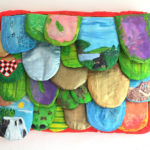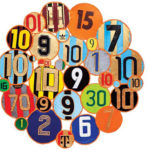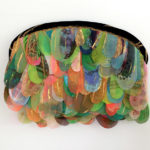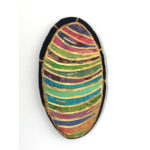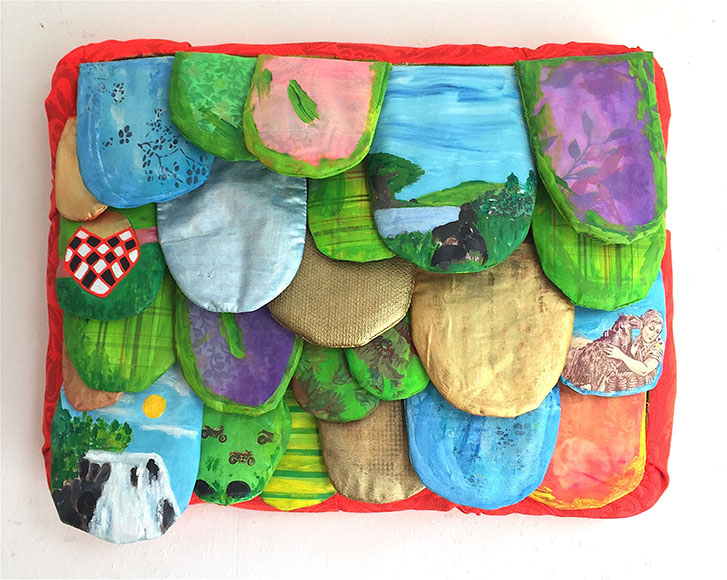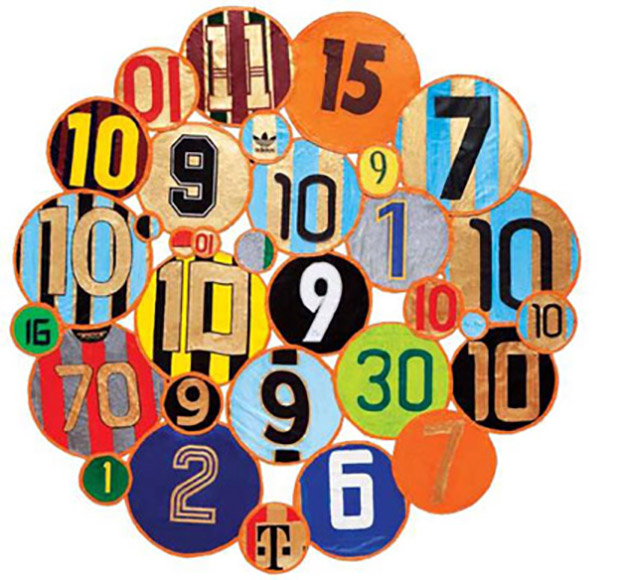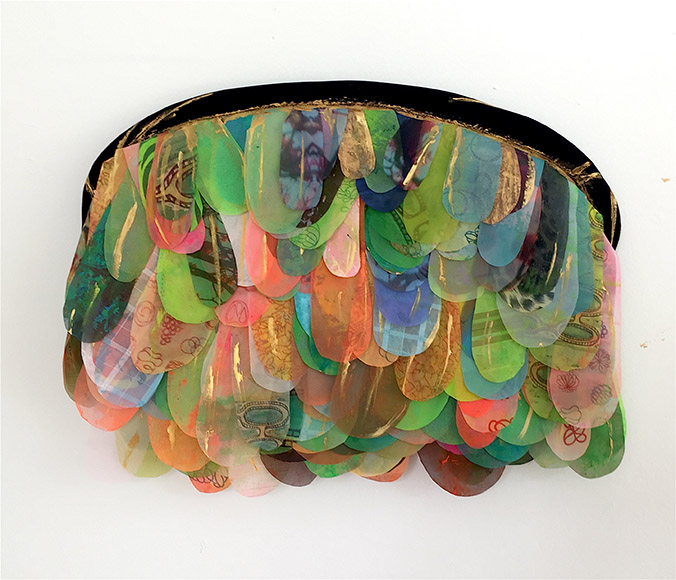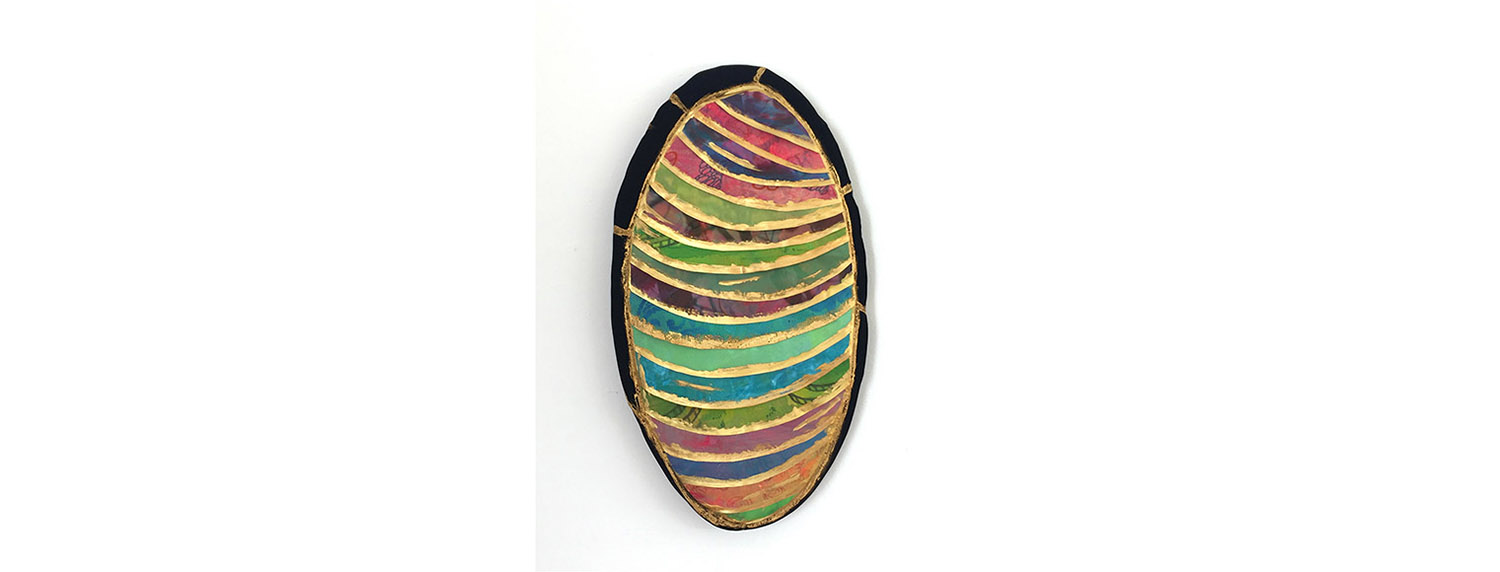The act of appropriation of “ready-made pictures” present in the artist’s poetics, maintained from the beginning, has in the change of nature of the appropriate materials a modification in her creation, and consequently in the visuality contained in them. If previously images and textures were present in everyday materials, such as blankets, towels and fabrics used in decoration, or arising from the colors and subjects present, they became the predominant characteristic of the production soon after, after the use of the machine sewing to make fabrics, period in which her work removes daily images, eliminates some details, applies paint on sheets, towels, blankets, mattresses, mats, umbrellas, bathroom curtains and leather, generating new images. Printed figures were replaced for suggested figures. Presenting bellies, drops, insects and veils – which she creates by cutting out fabrics like velvet and silk in circular or oval shapes, where she attaches herself to geometric figures, eliminating narratives. The fabrics nailed to a flat canvas create volume, then receive layers of paint, finishing with the use of techniques such as sewing. It is what she calls “soft paintings,” paintings which, instead of being canvases with the surface covered with paint and attached to a chassis, are structured directly on the wall and, in addition to paint, they use fabrics such as voile, printed cotton, jeans, velvet and plastic. These features accompany the production of Leda Catunda until today, in an artwork where she works with volumes, thicknesses and textures, entailing in addition to the observation, a tactile and organic impulse, creations of an undeniable public acclaim, an art of inquiry about the perception of the world, personal and unmistakable, a work in tune with our time.
Leda Catunda was born and currently lives in São Paulo, Brazil. Graduated from Faculdade Armando Álvares Penteado (FAAP) in 1984, she has had undergraduate teachers – Júlio Plaza, Regina Silveira, Walter Zanini and others – who introduced her to the astonishing universe of conceptual art, as can be seen in her first works in lithography. Her exhibition debut came through the then MAC-USP director, Aracy Amaral, in the exhibition Pintura como Meio, in 1983. But it gained national prominence after participating in the exhibition at Geração 80, Como Vai Você? , at the Escola de Artes Visuais do Parque do Lage, Rio de Janeiro, in 1984. From this exhibition on, she has conquered the art critics and market. In addition to being a painter, multimedia artist and recorder, Leda Catunda used to teach at FAAP from 1986 to the mid 90’s, and she studied PhD in visual poetry at the Escola de Comunicações e Artes da Universidade de São Paulo, in 2001. In her career she has participated in three São Paulo Biennials (1983, 1985 and 1994) and large collective exhibitions such as Modernity (Paris, 1987), Latin American Artists of the 20th Century (Museum of Modern Art in New York, 1993) and Mostra do Redescobrimento (São Paulo, 2000) having her artwork featured in Brazil and abroad, exhibiting in places such as Spain, France, Holland, Portugal, Sweden, Germany, Cuba, Argentina, Puerto Rico, Venezuela, Mexico, the United States, Japan, Australia and several cities from Brazil. About her work, the Cosac & Naify publisher released a book with her name as the title, by Tadeu Chiarelli.
Her work begins with the appropriation of images – taken from TV, through photography; images from children’s towels, printed fabrics – and placing an intervention on them leaving details of the images showing. Now, you are showing an exposition with a visual repertoire based on the sport universe. From that point, let’s go to some questions:
How can you describe in your trajectory the appropriation of the images, and the erasing, redesign and processing of these images to create your work? What has changed from the towels to the sports jerseys? Can you describe the process?
The fact that I appropriate these materials, usually fabrics or soft objects containing prints, is due to the enormous excess of images that we find in the world today. This appropriation procedure has been my main expression, which I’ve been repeating since the beginning of my creative process with the “sealing” from the 1980’s. The difference, when it comes to the sports universe is the challenge of working with very strong and meaningful images which belong to the popular universe, since everyone is a fan of a team or roots for someone or something.
Is your appropriation of images a criticism, if we may call it so, between a virtual and a concrete reality?
Partially, yes. Ambiguously there is a criticism as to the ferocity of the consumption created around these idols, but it is also a tribute. The faith, the love, the affection, in other words, all the emotional side filling the heart of the fans in general. However, even I can’t see all this differentiation between the real and the virtual, it is not something I worry about.
What does the use of these images provoke as irony and metalanguage not only in your work, but in your relationship with art, with contemporary society as a whole?
I can’t control the relationship between the ironic and the poetic, that’s something only the audience can figure out.
In the catalog text accompanying the exhibition, it is written: “The recent decision to turn to the sports universe is perfectly coherent and understandable, almost logical.” What made you decide to take the world of sports and its iconography as a theme in this show? Was it really a logical decision?
It was mainly a new phase of my life, in which I started following more assiduously several types of championships, including motorcycle, skate, swimming, tennis and soccer – ESPN in general. Therefore, I was increasingly seduced by the strong images of striped or smooth shirts worn by the players, with their numbers, sponsorships and emblems, all treated graphically in the same way. This miscellany of love and value is what interests me. There is a very strong interest in the use of this material regarding the question of the identification of the subject. In the globalized world it seems to be of the utmost importance that each person finds their identification points, using a team’s jersey, a favorite rock band t-shirt, or whatever, as a type of mapping for both their personality and where they fit.
How do you see the possibilities of the image in art today?
I see it as basically endless, which represents both advantage and conflict at the same time, as the amount of images is far, far superior to any artist’s ability to manipulate them.
Is there a trivialization of the image now?
I believe that there is a real massacre of the ordinary citizen’s eyeball, with images covering him from sneakers to cap, from the bathroom of his house to the airport hall. It is impossible to run from it. This is the pace of communication these days.
As for the relation between painting and object, bidimensionality and tridimensionality, and the questioning of your work’s physical limits, how important is this tension to your creation?
Since the beginning, I have developed my own way of “constructing” my painting-object. By using non-artistic materials, such as blankets, towels, T-shirts, plastics and velvets, among others, the works end up obtaining thicknesses and their very own forms, which confers them the object status. It is the procedure similar to that of gluing, the accumulation of materials, covered with acrylic paint, which confers volumes, overlaps and/or transparencies, which has been characterizing my work since always. I believe that a constructive character can be clearly observed in the constitution of each work. This is a natural process, which matters to me in attempting to engage the audience’s way of thinking.
Your painting, having this dimensioning to make visible the characteristics of the material, and also, although it is hanging on the walls, slipping on the floor or entering the space, can be identified as reliefs, or this leads only to a propensity to three-dimensionality?
The nomenclature that I prefer to refer to my production is really that of object-painting, which accounts for both the object’s constructive issue and the pictorial issues, in the struggle to construct a final image resulting from the sum: original print plus paint.
Your artwork suggests a tactile, organic, aesthetic appeal. Is this a goal for the integration with the audience?
The tactile aspect is not necessarily intended from the outset, but it is certainly verifiable in the results. And yes, almost everyone wants to touch it.
Overlays, layers of paint, the figure-bottom relation, no empty spaces. In your artwork, we are able to find a rhythm granted by the colors. What is your relation to color to make it a part of your work?
Color always poses a huge challenge to the artist, whether they are painters, or whether they are working in any other media. Full of meanings, own abilities and specific contrasts, in this present work, even more than in the previous one, it has been an intensely present issue with which I have been daily debating.
You are a pioneer in your generation in the use of sewing to prepare your work. What led you to use this service as a stage of your painting? Are you still creating with it? Does this exposition use sewing on your artwork?
My grandmother. I watched my Portuguese grandmother, Dona Laurentina, and learned how to sew from an early age. Then when I started painting on fabric, the subject of sewing came naturally. Yes, in this exhibition, almost all the materials went through my sewing machine.
Your formation goes through FAAP art school and later, getting masters and doctorate degrees. Having this academic experience, what are your thoughts about art teaching in Brazil?
I’m pleased with it. The universities normally receive many artists to compose the faculty, there is a huge interest in the area today and the university environment in almost every part of the country is effervescent.
How do you see the Brazilian art currently?
Not only in the arts, but also in other areas there is widespread enthusiasm. The truth is that the problems in the area are large, especially on the institutional side – museums and cultural institutions. What makes the difference is the enthusiasm that moves people in search of solutions and results.
What is your expectation for this individual exhibit in Bahia?
I’m overly pleased with the exposition. I will show in it the result of two to three years of work within this new subject of appropriation of sports equipment. I have a special fondness for Salvador, a city which I have visited several times when I was young. It took lots of love and affection to create this exhibit, I hope the audience appreciate it.
(Interview/November 2011)


